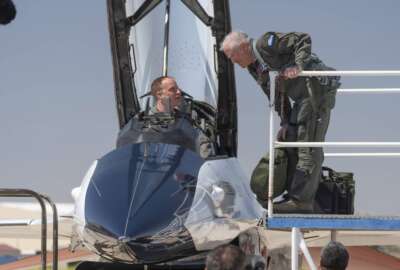Hubbard Radio Washington DC, LLC. All rights reserved. This website is not intended for users located within the European Economic Area.
On Air: Federal News Network
Air Force: Sequestration already creating ‘chronic inefficiency’
The Air Force's long-range planning and modernization takes back seat to preparations for near-term crises, including contingency plans to scale back civilian w...
To say nothing of the impacts that would occur if automatic federal budget cuts are actually triggered, the intensive planning efforts and pre-emptive spending reductions the Air Force is already undertaking as preemptive measures are taking a toll on military preparedness and combat capability, officials said Thursday.
Like the other military services, the Air Force has already taken preliminary measures to slow the rate at which it’s spending money in the current fiscal year though measures such as a civilian hiring freeze and conference cancellations. But some of the longer-term impacts will come from the mere fact that the Air Force’s planners have been distracted by a seemingly constant string of budget crises, said Dr. Jamie Morin, the acting undersecretary of the Air Force.
“In an ideal world you’d want your Department of Defense leadership focusing on organizing, training and equipping the force the nation needs in a potential contingency five or ten years from now. Sequestration has us looking a month from now, a week from now, a day from now,” he said. “It’s like driving down a highway at 70 miles an hour staring right at your hood ornament. It’s not a recipe for success.”
Morin told reporters at the Pentagon the Air Force estimates that the combination of the March 1 sequestration cuts and a full-year continuing resolution in the absence of an enacted DoD budget would leave the service with a $12.4 billion shortfall by the end of the year if it took no action to reserve funds. Besides the hiring and travel cutbacks, the Air Force has already ordered its major commands to cut back on all unnecessary spending and cancelled all non-emergency maintenance to its facilities.
“This is a pretty serious pull-back,” he said. “It hits things like runway repairs, taxiway repairs, lighting system repairs, sewer lines, energy efficiency improvements, all of the rest of those sorts of installation-level activities that we carry on. We’ve got a list of over 400 projects that will be affected, hitting 140 different installations, 34 states, numerous overseas countries. This is a pretty big deal. It may not get as much attention as sometimes the effects on the big major acquisition programs, yet the reality is at local levels bases are already beginning to see projects deferred that will yield deteriorated facilities and a significant hit to the local contractor work forces that perform that kind of work for us.”
Besides construction, cutbacks already in place at the major command level include expenditures on service contracting, IT projects and facility support. Morin said those reductions have already taken a noticeable bite out of the small business contracts the Air Force was planning to execute for the year, and comes at a time when the service was struggling to turn around a decline in small firm contracting that had lasted several years.
“That is clearly at risk, and frankly out the window if sequestration hits,” Morin said. “We’re already seeing a three percentage point decline in our [small business] utilization, which will more than reverse the progress that we’ve made. It’s a $100 million deterioration so far.”
Furloughs necessary under sequestration
If sequestration occurs, the Air Force will make another series of cuts that it says would be more damaging, and more difficult to reverse.
Like the other services, it would immediately begin to furlough each of its 120,000 civilian employees for one day a week for the remainder of the fiscal year, which ends in September, a move Morin said would be a “destructive breach of faith” with the Air Force’s non-uniformed workforce.
Impact to military missions would be especially severe in Air Force operations that are dominated by civilian employees, said Gen. Larry Spencer, the Air Force’s Vice Chief of Staff.
“I have spoken with several of our Airmen in the field about sequestration and what it would mean to them. A flying training wing commander at the busiest airfield in the Air Force is extremely concerned about what will happen to his work force since his entire maintenance team consists of government civilians,” Spencer said. A combination of a decreased workforce and a shortfall in cash to purchase spare parts and perform maintenance would create a “bow wave” of deferred aircraft depot repair into 2014, when the Air Force’s cash picture isn’t expected to be any brighter.
“We have $11 billion programmed to spend this year. Of that, we will have spent half of that by the first of March,” Spencer said. “Of the remaining $5.5 billion, sequestration will result in a cut of roughly $2 billion. That means we will not be able to perform crucial maintenance on approximately 150 aircraft and more than 80 engines of all types in all of our depots. Not only will this have a significant impact on aircraft available to fly missions, it will also drive a ripple effect through our depots that could take five years or more to recover.”
Sequestration’s impact on flying hours for pilots would be similar, the officials said. If the cuts take place, the Air Force would have to reduce flying hours by 200,000, or 33 percent for the remainder of the year. About two-thirds of the Air Force’s air crews would not be able to spend enough flying hours to stay fully mission-capable, they said.
Spencer said it would take the Air Force several months to recover from 2013’s punitive sequestration cuts, assuming it has more flexibility to decide where to spend money in 2014.
“If you sit an airplane down and don’t fly it, things start to break,” he said. “The thought is if you ground airplanes and have pilots not training, and oh by the way the maintenance folks aren’t training either because they aren’t fixing the planes as they take off and land, and that runs through the summer, you can’t jump in that airplane on 1 October and go respond to a contingency that they haven’t trained in for several months, and the airplanes have not been worked and ready to fly.”
On the acquisition front, Morin said the Air Force would do everything it could to protect its existing major hardware procurement programs, in part, because reopening and renegotiating those deals, such as the one it struck for the new KC-46A refueling tanker, could turn out to be enormously costly.
“We’re going to do everything in our power to not break that main contract. We got an exceptionally good deal, and if we lost that contract we’d be renegotiating in a sole-source environment instead of in a competitive environment, and it’s hard to see that ending well for the government either in terms of delivery of the capability or cost.”
That doesn’t mean modernization programs wouldn’t suffer though, he said. For example, the Air Force would have to cancel plans to buy two new space-based infrared (SBIR) surveillance satellites. And even if the prime contracts for programs such as the KC-46A are held intact, many of the supporting programs that orbit it will not be.
“What you’re going to almost certainly see happen is that those sorts of supporting activities, whether they’re done by government employees or whether they’re done by outside contractors, are going to get squeezed first and tightest, because those are things that can be slipped and moved around without derailing the fundamental program sometimes,” he said. “So I would expect to see in any product set, very significant reductions to those sorts of support activities that are in the long run vital to the success of the program. And again, they’re often done by small businesses, done by boutique firms that have special capabilities that we rely on. There’s an industrial base issue here as well where we may lose some of those capabilities.”
RELATED STORIES:
Air Force’s sequestration hit would mean less of everything
Pentagon orders planning for civilian furloughs, other cutbacks
By year’s end, troops will be unable to respond to crises, Pentagon says
TAG: DoD Air Force Sequestration Dod budget Jamie Morin Larry Spencer Furloughs Workforce Jared Serbu
Copyright © 2024 Federal News Network. All rights reserved. This website is not intended for users located within the European Economic Area.
Jared Serbu
Jared Serbu is deputy editor of Federal News Network and reports on the Defense Department’s contracting, legislative, workforce and IT issues.
Follow @jserbuWFED





